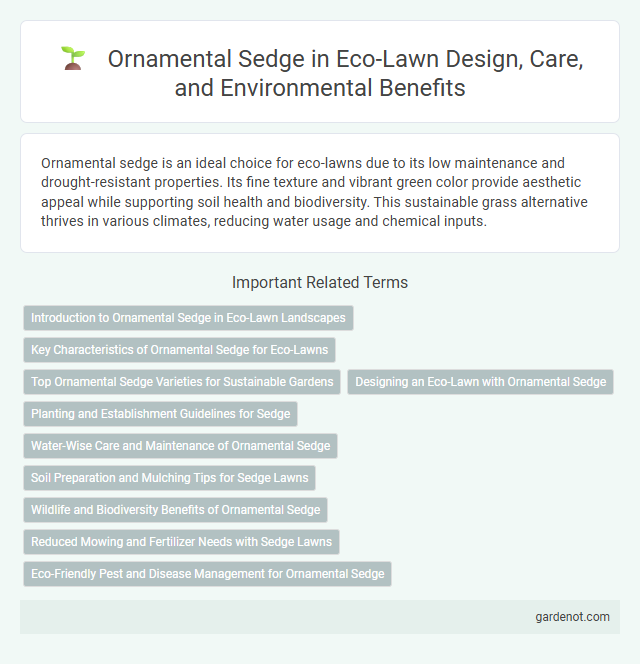Ornamental sedge is an ideal choice for eco-lawns due to its low maintenance and drought-resistant properties. Its fine texture and vibrant green color provide aesthetic appeal while supporting soil health and biodiversity. This sustainable grass alternative thrives in various climates, reducing water usage and chemical inputs.
Introduction to Ornamental Sedge in Eco-Lawn Landscapes
Ornamental sedge (Carex spp.) is a low-maintenance, drought-tolerant grass alternative that enhances eco-lawn landscapes with its fine texture and vibrant green hues. It thrives in diverse soil conditions, promoting soil health and reducing water usage compared to traditional turfgrass. Incorporating ornamental sedge into eco-lawns supports biodiversity by providing habitat for pollinators and beneficial insects.
Key Characteristics of Ornamental Sedge for Eco-Lawns
Ornamental sedge features fine-textured, grass-like foliage that enhances soil stability and reduces erosion in eco-lawns. Its high drought tolerance and low maintenance requirements make it an ideal choice for sustainable landscaping. This perennial plant thrives in various light conditions, supporting biodiversity and promoting a healthy lawn ecosystem.
Top Ornamental Sedge Varieties for Sustainable Gardens
Ornamental sedge varieties such as Carex morrowii, Carex oshimensis, and Carex elata thrive in eco-lawn designs, offering drought tolerance and low maintenance requirements that align with sustainable gardening principles. These sedges provide year-round texture and color diversity, enhancing biodiversity while reducing the need for chemical fertilizers and excessive watering. Incorporating top ornamental sedge varieties into landscapes supports soil health and promotes a resilient, eco-friendly garden ecosystem.
Designing an Eco-Lawn with Ornamental Sedge
Ornamental sedge thrives in eco-lawn designs due to its low maintenance and drought-resistant properties, making it ideal for sustainable landscaping. Incorporating various sedge species promotes biodiversity and enhances soil health while providing year-round texture and color. Its dense root system reduces erosion and improves water retention, supporting an environmentally friendly lawn alternative.
Planting and Establishment Guidelines for Sedge
Ornamental sedge thrives best in well-drained soils with moderate moisture levels, requiring partial to full shade for optimal growth. Plant sedge in early spring or fall, spacing clumps 12-18 inches apart to allow for natural spreading and dense ground cover formation. Regular watering during establishment ensures root development, while minimal fertilization maintains its low-maintenance, eco-friendly character.
Water-Wise Care and Maintenance of Ornamental Sedge
Ornamental sedge thrives in eco-lawns due to its low water requirements and resilience, making it ideal for water-wise landscaping. Regular maintenance involves minimal irrigation, typically requiring only natural rainfall once established, which conserves water resources effectively. Mulching around the base helps retain soil moisture, reduces weed growth, and supports healthy root development in ornamental sedge.
Soil Preparation and Mulching Tips for Sedge Lawns
Ornamental sedge thrives in well-drained, moderately fertile soil with a pH between 6.0 and 7.0, requiring thorough soil preparation that includes aeration and the removal of weeds to promote healthy root development. Applying a 2-3 inch layer of organic mulch, such as shredded bark or leaf mold, helps retain soil moisture, regulate temperature, and suppress weed growth in sedge lawns. Regularly refreshing mulch and avoiding heavy applications prevent fungal issues while supporting an eco-friendly, low-maintenance lawn environment.
Wildlife and Biodiversity Benefits of Ornamental Sedge
Ornamental sedge provides essential habitat and food sources for various pollinators, birds, and small mammals, enhancing local biodiversity in eco-lawn settings. Its dense root systems improve soil health and water retention, supporting a thriving ecosystem by reducing erosion and promoting beneficial microorganisms. By integrating ornamental sedge into eco-lawns, gardeners contribute to sustainable wildlife corridors and increased habitat connectivity.
Reduced Mowing and Fertilizer Needs with Sedge Lawns
Ornamental sedge lawns require significantly less mowing due to their slow and dense growth habit, making them an eco-friendly alternative to traditional grass lawns. Their deep root systems improve soil health and reduce the need for frequent fertilization by enhancing nutrient retention and supporting beneficial microorganisms. This combination of low maintenance and natural soil enrichment makes sedge lawns a sustainable choice for water conservation and reducing chemical inputs in lawn care.
Eco-Friendly Pest and Disease Management for Ornamental Sedge
Ornamental sedge thrives with eco-friendly pest and disease management strategies that minimize chemical use and promote biodiversity. Incorporating natural predators such as ladybugs and parasitic wasps effectively controls aphids and other pests, while maintaining healthy soil with organic mulches reduces disease incidence. Regular monitoring and selecting disease-resistant varieties further enhance the sustainability and resilience of ornamental sedge in eco-lawn landscapes.
Ornamental sedge Infographic

 gardenot.com
gardenot.com